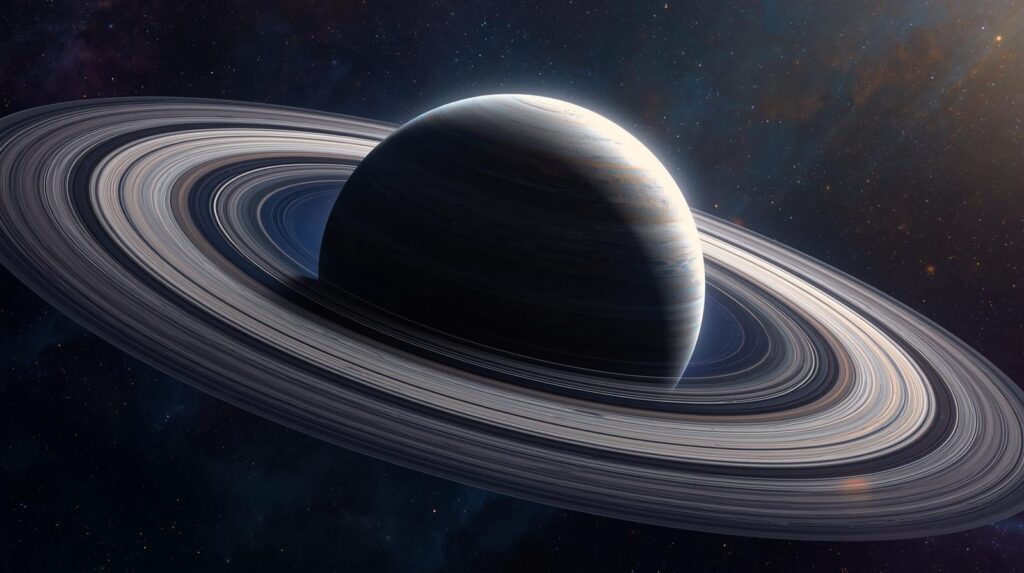Which Planet possesses largest Ring System?
When we say the word “rings,” everyone’s first mind goes immediately to Saturn. Those beautiful, shining rings have been a curiosity for astronomers and space buffs for centuries. But do you know that Saturn’s not the only planet with rings? In fact, all the gas giants of our solar system, Jupiter, Saturn, Uranus, and Neptune, all have ring systems. However, Saturn has the largest and most brilliant rings among them all.
Saturn’s Rings
Saturn’s rings are made up of millions of small ice, rock, and dust particles. They range from infinitesimal grains to boulders measuring as big as a mountain. Saturn’s rings are made up of different segments, which are labeled A, B, C, D, E, F, and G rings.
Some interesting facts about Saturn’s rings:
They are really, really thin, just 30 feet thick in certain places, but stretch several hundred thousand kilometers wide.
They are glowing because they are made mostly of sunlight-reflecting water ice.
There are gaps in some rings, which are created by Saturnian moons developing gravitational “shepherding” effects.

Largest Ring System Around Other Worlds
While Saturn’s rings are biggest, gas giants other than Saturn also have rings.
Jupiter has thin rings made mostly of dust. They cannot be observed without a telescope.
- Uranus has dark, narrow rings that were discovered in 1977.
- Neptune has tenuous, fragmented rings discovered in the 1980s.
- Saturn’s rings remain the most evident and showy, so most individuals just consider rings when they hear Saturn.
Fun Things to Learn About Saturn’s Rings
You don’t have to be an astronomer to be fascinated with Saturn’s rings. There are numerous other resources for Earth Science and space that make learning exciting.
- Word Searches
Try to find words like Saturn, rings, ice, moons, gravity, particles in a word search puzzle. This is how scientific terms can be fun to learn.
- Crossword Clues
Crosswords are great to test your knowledge. For example:
Clue: “The planet famous for its enormous rings” → Saturn
Clue: “Little celestial body revolving around a planet” → Moon
- Quizzes
Take easy quizzes online to see how much you really know about Saturn and its rings. For example:
Question: How thick are Saturn’s rings?
Question: What are Saturn’s rings made of?
- Clipart and Pictures
NASA and other science sites have wonderful photos of Saturn and its rings. You can reproduce them for classroom projects or use them to make awesome posters.
- Projects
Hands-on activities help you learn concepts better. Projects include:
Modeling Saturn’s Rings: Create a miniature Saturn ring system with cardboard, glitter, and beads.
Moon and Ring Interaction: Illustrate how moons affect ring gaps with a string and tiny balls.
- Daily Space Photos
Follow NASA’s photo of the day to see real images of Saturn, its moons, and other planets. The pictures generate curiosity and make learning fun.
Why Saturn’s Rings Are Unique
- Largest Ring System: There is no other planet with rings as expansive and visible as these.
- Brilliant and Vibrant: The ice and rocks diffract the sunlight, making Saturn look magical when viewed through telescopes.
- Diverse Structure: With millions of particles and gaps, the rings show us how gravity works in space.
- Rings of Saturn also help scientists study solar system evolution and the formation of planets, making them useful for learning about space and Earth Science as well. A lunar eclipse does impact the Blood Moon in some way.
More Fun Resources
Word Search: Uncover space vocabulary words like planet, rings, gravity, orbit, and telescope.
Crossword Clues: Interactive puzzles for students learning about planets.
Quizzes: Quiz on knowledge of Saturn, its rings, and planets.
Clipart and Pictures: For projects, presentations, or coloring pages.
Mini Projects: Model the rings using household items and show students how they revolve.
These materials add to the learning about Saturn and make it an interactive and engaging subject for students.
Conclusion: Largest Ring system
Saturn has the largest and most spectacular ring system in our solar system, but rings are boring to learn about. Space can be made fun with word searches, crosswords, quizzes, jokes, clipart, projects, and daily pictures. The next time you look at Saturn through a photo or telescope, you will not only be amazed at how pretty it is, but also will know the incredible science that goes behind those shiny rings.
Saturn’s rings remind us that space is full of surprises, and studying them can be both enlightening and amusing.
